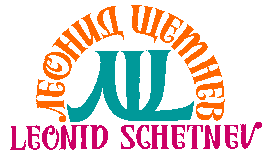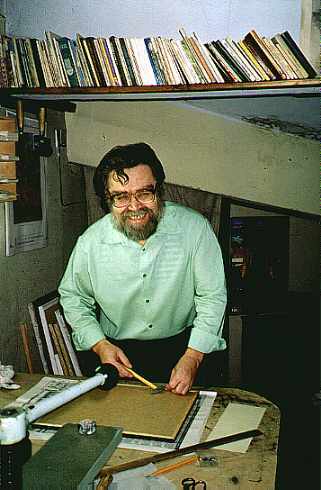
Ex libris. What is it?

You have opened a book and on the inside of the front cover you suddenly notice a small
engraving or a label pasted usually in the top left-hand corner.
It is an "ex libris" - a special sign of the owner of a library, his (her)
library's emblem, its heraldic symbol.
"Ex libris" is a Latin word. It means "from books of". The bookplate
(another name of ex libris) reflects spiritual world of the owner, his tastes in
literature, his professional and personal interests. Some bookplates can represent various
symbols, signs, emblems, some conventional signs or just some text only.
Usually the text is inserted together with the picture: "Ex libris..." and then
the surname of the owner follows. Or "From books of..." such-and-such a person,
for example, "From books of V.Ivanov", or "From the Library of
I.Sidorov".
A bookplate is usually ordered to an artist, a specialist, and can be made with any of
graphic techniques: pen and ink drawing, wood engraving (xylography), plastic engraving,
linoleum block, as well as in the technique of etching and lithography.
Then, if the customer likes, the artist can make small number of printings (more than а
thousand copies are usually published in printing houses or on photocopying machine), and
the owner will be able to paste these bookplates on each book belonging to him.
A book sign, well designed, well printed, neatly pasted in the book, decorates it, being
some kind of its passport.
What is an engraving?
The engraving (or plate) is a reprint made by using a typographic technique from a
cliche, or printed form which has been cut out by an artist, the author of a design, with
the help of special cutters (burins) on wood or polymeric flooring, plastic or metal.
Generally engravings are made with the use of high print method. The convex places, which
the artist keeps untouched by a cutter are covered with paint spread evenly with a roll.
Then, applied on a paper sheet with some pressure, the paint passes on it.
The lines, dots and grooves of any kind made by the artist with burins, will remain white
on the paper.
Many techniques and mediums are used to create engravings of which one can read in special
literature.
Each reprint made directly out of the cliche is an original product of an artist, and an
author has the right to sign it. The signature is normally put with a lead pencil not to
spoil the view on a reprint and not to interfere with the main image. From a print made by
zinc etching method one can make a cliche on a metal plate, which even having the best
quality may not correspond precisely to the original.
One also can make a photocopy of a reprint and make the following prints using the offset
method. But a genuine reprint from an author's engraving has more values and
characteristic features reflecting the peculiar properties of the material on which the
engraving is carved. That is why such an engraving has a higher value.
If you want to order a bookplate.
The artist Leonid Schetnev works in the technique of plastic engraving, close to
xylography (wood engraving). This hard material (plastic) allows the artist to use any of
technical methods of carving and to get high-quality prints.
Samples:


If You decided to order a bookplate, write to the artist and enclose the necessary
information:
1. The text You want to have on the bookplate: "the book of such-and-such a
person", or "Ex-libris..." and the surname and initials, or the surname,
the first name and the patronymic fully, or only the name with the initial letter of your
surname, or a monogram from your initial letters of your surname, name, and patronymic.
2. Tell about yourself, your library (what books it consists of), your own passions,
literature bents and everything you want to see in the pictorial part of the bookplate and
mention everything that may be necessary in this connection.
After it the artist begins to work on the design and then sends it to the owner for
approval.
Sketches are made with pencil on paper. After the customer approves of the sketch the
customer and the artist make an agreement about terms of completing the work and the size
of payment. The artist writes a letter with the guarantee to finish the work on time, and
the customer sends the money.
A bookplate (a sketch and a print) depending on complexity of the plot, the size of the
bookplate, costs from 30 till 150 dollars. This work includes also 10 first prints with
the autograph, which the artist sends the owner only after the payment has been made.
At extra cost the artist can print up to1000 copies, as well as send the cliche to a
client.
General bookplates (prefabricated ones) and sketches.
Sometimes the owner does not know exactly what a future bookplate will look like. In such
cases the artist offers projects of so called general bookplates: prefabricated ones and
sketches. Stocking up is a ready bookplate, engraved on plastic. The only thing the artist
should do is to engrave the text on the book sign.



Some sketches



Several general prefabricated plates





The artist also collects ex libris and will be glad to exchange bookplates.
 Biography
Biography
Leonid Nikolayevich Schetnev was born in 1942 in the town of Sokol in the Vologda region.
He graduated from the Graphic Arts Faculty of the Kostroma Pedagogical Institute in 1981.
His diploma was devoted to the bookplate, his passion for the bookplate began in 1867 .
Since then Leonid Schetnev has been a participant of numerous national and foreign
exhibitions, about 10 personal ones, the last exhibitions were in Vologda (1997), in the
Museum of Bookplate in Moscow (1999).
Schetnev participated in the International Exlibris Congresses in Linz (Austria) - 1980г.
and in Saint Petersburg - 1998г.
Since 1982 he is a member of the Artists' Union of Russia
The artist has created more than 300 bookplates, about 50 easel engravings, more than 30
complimentary postcards.
Leonid Schetnev has designed several books. All works are executed in the technique of
plastic engraving - letterpress printing.
Engraving on plastic
Format__________________
Cost of the original print with the autograph ________________________
Engraving on plastic
Format__________________
Cost____________________
Colour engraving on plastic
Format__________________
Cost____________________
Information on the artist:
Post address: RUSSIA
160035 g.Vologda
P.O. 30
Schetnev L.N.
Correspondence in Russian, English, German languages.